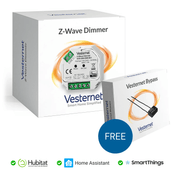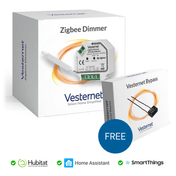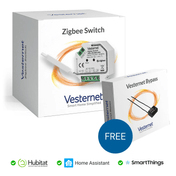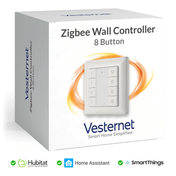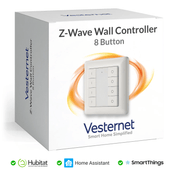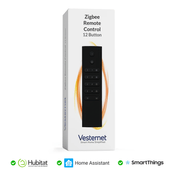Smart home climate monitoring has become essential as homeowners seek precise environmental control and energy efficiency, with temperature and humidity sensors now serving as the backbone of automated comfort systems. Modern indoor air quality monitoring systems extend far beyond basic thermostats, offering comprehensive environmental data that rivals professional arduino indoor air quality setups.
This comprehensive comparison will help you choose between two leading Zigbee sensors—the industrial-grade Aqara T1 with air pressure monitoring versus the maintenance-free NodOn with solar power technology. As a trusted UK smart home specialist, Vesternet has extensively tested both sensors across various home environments to provide you with unbiased, practical insights for your decision.

Aqara T1: Industrial-Grade Environmental Monitoring
The Aqara Temperature and Humidity Sensor T1 represents the pinnacle of precision climate monitoring, utilising advanced Sensirion sensor technology that delivers industrial-grade accuracy. This comprehensive indoor air quality monitoring system offers temperature detection accuracy of ±0.3°C and humidity detection accuracy of ±3%, specifications that rival professional laboratory equipment.
Advanced Monitoring Capabilities
- Built-in air pressure sensor for comprehensive atmospheric monitoring
- Real-time historical data tracking with smartphone alerts
- Remote monitoring with customisable threshold notifications
- Seamless home automation integration with other Aqara devices
The T1's standout feature is its built-in air pressure sensor, providing accurate real-time atmospheric pressure measurements that complement temperature and humidity data. This tri-sensor approach creates a complete environmental picture, making it comparable to sophisticated arduino indoor air quality monitoring setups used by electronics enthusiasts.

NodOn Zigbee: Solar-Powered Climate Intelligence
The NodOn Zigbee Temperature and Humidity Sensor revolutionises climate monitoring through its innovative solar-powered design, eliminating battery maintenance whilst maintaining reliable performance. This compact sensor measures conditions every 100 seconds, automatically updating when temperature changes by 0.5°C or humidity varies by ±2%.
Solar-Powered Innovation
- Ambient light solar cell powers continuous operation
- Optional CR2032 backup provides three years of dark-room operation
- Hourly "heartbeat" signal ensures consistent connectivity
- Zigbee 3.0 compatibility for strong mesh network integration
The sensor's smart reporting system optimises battery life and network efficiency by transmitting updates only when meaningful changes occur. This intelligent approach makes it an excellent component of any indoor air quality monitoring system, particularly where maintenance access is limited or where eco-conscious operation is prioritised.
Power Source Innovation: Battery Dependence vs Solar Freedom
The fundamental difference between these sensors lies in their power management philosophy. The Aqara T1 relies on traditional battery power, requiring periodic replacement but enabling consistent performance regardless of lighting conditions. The NodOn sensor embraces solar innovation, harvesting ambient light to achieve virtually maintenance-free operation.
Power Management Comparison
- Aqara T1: Standard battery replacement every 1-2 years
- NodOn: Solar-powered with optional 3-year backup battery
- Installation flexibility varies significantly between models
- Maintenance requirements differ dramatically in long-term use
Installation flexibility presents another key distinction. The battery-powered Aqara T1 can be positioned anywhere within Zigbee range, making it ideal for dark cupboards, basements, or rooms with limited natural light. Meanwhile, the NodOn sensor requires adequate ambient light for optimal solar operation, though its backup battery option provides flexibility in darker environments.
Unique Feature Sets
The Aqara T1's air pressure monitoring capability sets it apart from standard climate sensors, providing comprehensive atmospheric data that enhances weather prediction and supports advanced automation scenarios. This feature particularly benefits users creating sophisticated indoor co2 sensor networks or comprehensive environmental monitoring systems. The NodOn sensor compensates with its eco-friendly operation and simplified installation process, appealing to users prioritising sustainability and minimal maintenance.
Accuracy specifications reveal both sensors deliver reliable measurements, though the Aqara T1's industrial-grade Sensirion components provide slightly superior precision. The NodOn's smart reporting algorithm ensures efficient data transmission whilst maintaining acceptable accuracy levels for most residential applications, making it suitable for integration with broader indoor air quality monitoring systems.
Real-World Accuracy: Response Times and Reliability Testing
Performance testing across various home environments reveals distinct characteristics in each sensor's operation. The Aqara T1 demonstrates consistent measurement precision regardless of lighting conditions, maintaining its ±0.3°C temperature accuracy and ±3% humidity precision across different installation locations.
Response Time Analysis
- Aqara T1: Rapid response to environmental changes
- NodOn: Smart 100-second measurement intervals
- Both sensors maintain stable Zigbee connectivity
- Performance varies with ambient lighting conditions
The NodOn sensor's 100-second measurement cycle provides adequate responsiveness for most residential applications whilst optimising power consumption. Its smart reporting threshold (0.5°C temperature change, ±2% humidity variation) ensures meaningful updates without overwhelming the Zigbee network. This approach proves particularly effective in stable environments where frequent micro-adjustments aren't necessary.
Environmental Adaptability
Testing in various lighting conditions highlights the NodOn's adaptability, performing reliably in typical indoor lighting whilst gracefully transitioning to backup battery mode in darker environments. The Aqara T1 maintains consistent performance regardless of lighting, making it particularly suitable for challenging locations like wine cellars, storage rooms, or mechanical spaces where comprehensive indoor air quality monitoring systems require reliable operation.
Connectivity stability proves excellent for both sensors, with strong Zigbee 3.0 mesh networking ensuring reliable data transmission even in challenging RF environments. Both integrate seamlessly with popular home automation platforms, supporting the creation of responsive climate control systems.
Aqara T1: Precision Performance with Maintenance Trade-offs
The Aqara T1 excels in applications demanding maximum precision and comprehensive environmental data. Its industrial-grade Sensirion sensors deliver laboratory-quality measurements, making it ideal for users requiring professional-level accuracy comparable to dedicated arduino indoor air quality monitoring setups.
Precision Advantages
- Industrial-grade ±0.3°C temperature accuracy
- ±3% humidity precision across all conditions
- Built-in air pressure monitoring capability
- Consistent performance in any lighting environment
The T1's comprehensive feature set supports advanced automation scenarios, particularly where air pressure data enhances weather prediction or indoor air quality analysis. Its reliable battery operation ensures uninterrupted monitoring in challenging environments, though this convenience comes with the trade-off of periodic battery replacement. The sensor's robust construction and proven reliability make it an excellent choice for critical monitoring applications where precision cannot be compromised.
NodOn Zigbee: Maintenance-Free Convenience with Power Limitations
The NodOn sensor prioritises user convenience through its innovative solar power system, virtually eliminating maintenance requirements whilst delivering reliable climate monitoring. Its compact design and wireless installation appeal to users seeking hassle-free operation without compromising essential functionality.
Convenience Benefits
- Solar-powered operation eliminates routine maintenance
- Simple installation without wiring or frequent battery changes
- Smart reporting optimises network efficiency
- Three-year backup battery option for dark environments
The sensor's eco-friendly approach aligns with modern sustainability goals whilst providing practical benefits through reduced maintenance schedules. However, optimal performance requires adequate ambient light, potentially limiting installation locations in very dark spaces. The optional backup battery addresses this limitation, though it reintroduces maintenance considerations. Despite these constraints, the NodOn sensor excels in typical residential environments where its solar technology can operate effectively, making it an attractive component of comprehensive indoor air quality monitoring systems.
Choosing Your Perfect Climate Monitor: User-Specific Recommendations
Selecting between these sensors depends on your specific priorities, environmental requirements, and automation goals. Different user types will find distinct advantages in each model's design philosophy and feature set.
For Technical Enthusiasts and Precision-Focused Users
The Aqara T1 suits users who demand maximum accuracy and comprehensive environmental data. Electronics enthusiasts familiar with arduino indoor air quality projects will appreciate the T1's industrial-grade specifications and air pressure monitoring capability. Its precision makes it ideal for wine storage, server rooms, or anywhere accurate environmental control is critical.
- Choose T1 for laboratory-grade accuracy requirements
- Ideal for challenging environments with limited lighting
- Perfect for users prioritising comprehensive data collection
- Best for integration with sophisticated automation systems
For Eco-Conscious and Convenience-Oriented Users
The NodOn Zigbee sensor appeals to environmentally conscious homeowners who value maintenance-free operation. Renters particularly benefit from its wireless, adhesive installation that leaves no permanent modifications. Families appreciate the "set and forget" convenience, whilst sustainability-minded users value the solar power innovation.
- Select NodOn for maintenance-free operation
- Excellent for rental properties requiring non-invasive installation
- Ideal for users prioritising eco-friendly technology
- Perfect for typical residential indoor air quality monitoring systems
Application-Specific Considerations
Consider your specific monitoring environment when making your choice. Dark locations like basements, cupboards, or storage areas favour the battery-powered Aqara T1, whilst well-lit living spaces suit the solar-powered NodOn sensor. Users building comprehensive indoor co2 sensor networks might prefer the T1's additional air pressure data, whilst those seeking simple climate monitoring will find the NodOn's streamlined approach sufficient.
Smart Climate Control: Making the Right Sensor Choice
Both the Aqara T1 and NodOn Zigbee sensors excel in climate monitoring, but serve different smart home priorities and user needs. The Aqara T1 stands out for users who demand industrial-grade precision and comprehensive environmental data including air pressure, making it ideal for serious home automation enthusiasts and those requiring laboratory-level accuracy.
Final Decision Framework
- Prioritise Aqara T1 for maximum precision and comprehensive data
- Choose NodOn for maintenance-free convenience and eco-friendly operation
- Consider environmental lighting when evaluating solar power feasibility
- Match sensor capabilities to your specific automation requirements
Meanwhile, the NodOn Zigbee sensor appeals to eco-conscious homeowners and renters who prioritise maintenance-free operation and installation flexibility, with its innovative solar power technology eliminating battery concerns. Your choice ultimately depends on whether you value maximum precision and data richness, or prefer the convenience and sustainability of solar-powered, maintenance-free monitoring.
Consider your specific environment, automation goals, and maintenance preferences when deciding, and explore both options in Vesternet's smart home sensor collection to find your perfect climate monitoring solution. Whether you're building a comprehensive indoor air quality monitoring system or simply want reliable climate data, both sensors offer excellent foundations for your smart home journey.










